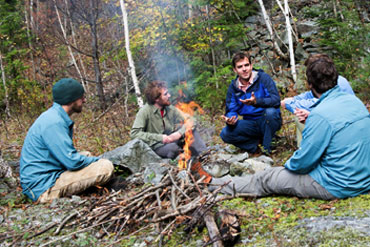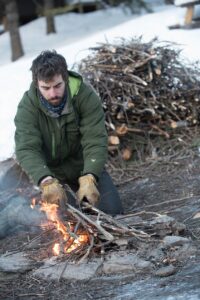
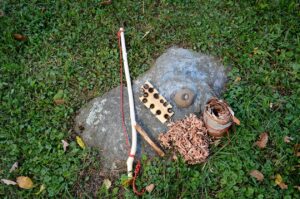 The successful completion of True North, like all life adventures, requires the acquisition of new skills and expertise. While the word “therapy” often suggests emotional or cognitive work, the Wilderness requires the acquisition of a set of physical skills as well. These physical skills relate closely to the social and emotional work that takes place at True North. An essential skill at True North is the art of fire-making. Consider for a moment the value of fire in the backcountry. Light, warmth, heat for cooking, the center of camaraderie; fire plays a central role in everyday life. And, it takes work! Gathering sticks of all sizes each day, finding rocks to build the fire pit, collecting birch bark and maintaining a fire-making kit are all critical to building and maintaining a fire.
The successful completion of True North, like all life adventures, requires the acquisition of new skills and expertise. While the word “therapy” often suggests emotional or cognitive work, the Wilderness requires the acquisition of a set of physical skills as well. These physical skills relate closely to the social and emotional work that takes place at True North. An essential skill at True North is the art of fire-making. Consider for a moment the value of fire in the backcountry. Light, warmth, heat for cooking, the center of camaraderie; fire plays a central role in everyday life. And, it takes work! Gathering sticks of all sizes each day, finding rocks to build the fire pit, collecting birch bark and maintaining a fire-making kit are all critical to building and maintaining a fire.

Upon arrival, many students have enjoyed a fire before, at some point, but are often new to the “flint and steel” technique of making fire, and almost always new to the general reliance on fire for meeting basic needs. There is no light switch, no gas range, no television, no dining room table, no heater (save the winter cabins). By this analogy, the fire is a type of versatile appliance. However, it is so much more.
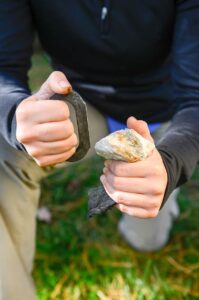
Lighting a fire using the flint and steel technique can be daunting. Imagine holding a white piece of quartz and striking a small, C-shaped piece of steel along one of its sharp edges. Striking the quartz creates a spark that must land on a small square of charred cotton. Once the spark has been “caught,” the cloth must be placed in a birch bark tinder bundle, or a “cone.” With patience and perseverance, the fire-maker blows air into the cone, generating a great cloud of smoke. As the smoke thickens, the birch heats up and bursts into flame! Once lit, the fire-maker puts the cone into the fire pit and adds the smallest available sticks. As these catch, she adds slightly larger sticks to the fire, building the strength of the flame. The size or design of the fire depends on its intended purpose. Boiling water for cooking requires small sticks that build a coal-bed. Building a fire for warmth and light requires bigger sticks, stacked in a more vertical fashion.

Like many new skills, fire-making is challenging and complex. The creation of the fire-making kit alone takes patience and focus. The physical act of creating a spark takes practice and assistance. Synthesizing each of the steps, from making char cloth (the charred cotton used to catch the spark), to folding the birch bark into a cone, takes time and perseverance. When all of these aspects culminate into that moment of ignition, there is both a sense of relief and excitement. A fire is either lit, or not. It is the epitome of “walking the walk.” As students work toward their first fire, they may feel anxious or nervous, or they may feel confident and relaxed. Either way, upon the completion of this task there exists a lasting sense of accomplishment and pride. The fire was lit, no matter how full of self-doubt the student had been before. There it is, undeniable evidence of efficacy and aptitude. From a place of dependence rises a sense of empowerment, and with that, a sense that they can provide for themselves and the people they care about.
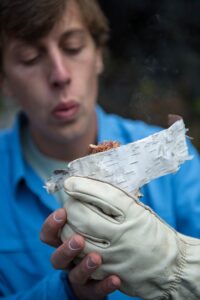
Some fires mean more than others. The first fire is generally a huge accomplishment and turning point for a student. For a student’s last night before graduation, students often build a bonfire, creating a great source of light and heat for the evening’s celebration. Whatever the occasion, fire brings people together. The flames dance and the embers glow. The firelight illuminates the faces of those in the circle. From the first day to the last evening, fire is a staple in the True North experience. It may pose as a challenge. It takes effort and skill. But, as anyone who has sat around a rip-roaring fire after a long hike will attest, the reward is always worth the effort.
